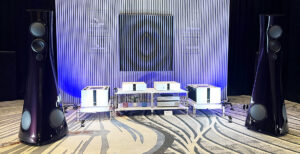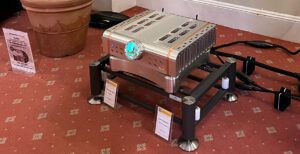
Some engineers are best described as ‘laconic’. Some take that a stage further and are effectively monosyllabic. This is completely understandable, as their job does not necessarily include a social interaction element. However, Mark Fenlon of Markaudio and Markaudio SOTA is not that kind of engineer. He’s more on the ‘communicative’ almost ‘loquacious’ side. He’s neither prolix nor garrulous however, and what he says is interesting, rather than some sort of engineering word salad, but if you want to ask a question as an interviewer, you are in that weird place of having to force your way into your own conversation. However, this is the stuff of lazy journalist’s dreams – turn on your recorder and keep going until the batteries run down!
Alan Sircom: How did y…
Mark Fenlon: I built my first pair of speakers when I was a penniless student, but I’ve been making components for other people since the early- to mid-1990s. I guess engineering is in my blood; my father worked for Jaguar – he was one of the development engineers for the company’s V12 engine – and my grandfather was a boilermaker, so give me a spanner and some nuts and bolts and I’m happy.
As a loudspeaker driver guy with a mechanical engineering background, I have made anything from frames to housings… all sorts of stuff. But I’ve always been intrigued by the fact that there’s not a lot of attention paid to the method, design, and structure of components in the traditional loudspeaker manufacturing industry, and it remains largely unchanged over time.. Yes, there has been some dabbling with Kevlar and fibreglass and the rest, but it’s an amazingly stuck-in-the-mud industry. In part, this is because of mass production and the need to produce a reliable, tried, and tested formula. Even if that formula hasn’t really changed since the pioneering days of Rice and Kellogg back in 1932.
I come from the energy industry (I was an industrial gas engineer and a gas dynamicist), but it would be fair to say that I’m a devotee of the Colin Chapman/Lotus school of engineering – “Simplify, then add lightness!” Most modern manufacturing industries from making mobile phones to building ships are all trying to gain mechanical system efficiency, use more modern materials, and reduce mass in the process. These are fairly standard engineering practices, but they all seem to have passed by the loudspeaker industry. But in the mid to long term, I believe that even the loudspeaker industry will have to learn how to do more with less, and we need to get transducers to become more efficient and use materials more wisely, more efficiently, and able to be reliably made that way. This last point is important, as most drivers go through at least seven glue or bonding processes, but I’m developing a driver that is effectively snap-to-fit, with only three glued processes. That’s far better for the environment, if nothing else.
To get the bandwidth on a Markaudio driver, we end up using aerospace-grade mixed alloys, which are never more than 150 microns thick. That not only gives the performance we desire, but means we are physically using less material: we’re getting that sheet of mixed alloy to go farther and do more, lowering costs, and helping the environment in the process. That is an engineer’s dream – if Colin Chapman were here, he’d be nodding his head in approval! As would many British engineers, because we’ve been brought up on this problem-solving way! It’s the way we are trained, or at least the way we were trained when I was at university. You can go too far, though – there was a famous interview with the owner of TVR about why their high-performance cars didn’t have safety functions like ABS and his answer was “learn how to drive properly, and don’t crash!”
I actually sold Markaudio (the raw driver business) and Markaudio SOTA (the finished loudspeaker brand) three years ago, and the two have morphed into something entirely different than what we imagined. This has given me the time and space to come up with more developments on cone design. For example, there is a cone design I’ve come up with what I call a ‘negative camber’ cone, but forgive me if I can’t say too much more at this time, as we are going through patent application as we speak.
With our current drivers however, in effect we have a symmetrical layout, as the shape and radii of the small cone and large cone in our drivers are almost identical. This allows us to use a general crossover in multi-way designs, which is advantageous. The first example of this in a loudspeaker design is the Viotti One. The last year and a half we have been getting feedback on the Viotti One, and we plan to keep that feedback going.
Part of the reason for that feedback is because if someone asks me what is a ‘good’ sound, I can’t say for sure. That’s for people to decide for themselves. On the other hand, if they ask me what is needed to produce a sound with a bandwidth from 40Hz–14kHz, I’ll go away and tinker and do that. If they say, I’d like it to have 90dB efficiency and give me a rough size of the driver, I’ll design it and the chances are I’ll produce a driver they will like. And historically Markaudio – the driver side – has been built up on constant feedback from end users, often through various forums.
With a loudspeaker like the Viotti One though, we hope that we’ve been able to make a two-way system that gets a little bit closer to the 21st Century. It’s not that we’ve made anything especially new – it’s still a transducer, with a coil, and a cone, and a magnet, etc. – but what we’ve done is made it technically more efficient, and that is the core of what we’ve been doing for the last three years; symmetrical driver layout with a general crossover in what we believe to be a stylish box. We’re not stylists, though – that’s where Andrea Ponti comes in. As a driver designer, the whole process has been very good for me, and I’ve enjoyed it enormously and it will be interesting to see how it works in the market.
Tags: FEATURED
By Alan Sircom
More articles from this authorRead Next From Blog
See all
AXPONA 2024 Show Report Part One
- Apr 19, 2024

Audio Show Deluxe 2024: A photo show report
- Mar 28, 2024

Paul Messenger 1949-2024: A personal tribute
- Mar 26, 2024

Bristol Hi-Fi Show 2024: See You There!
- Feb 21, 2024










